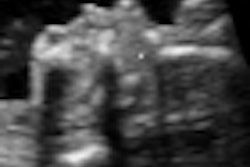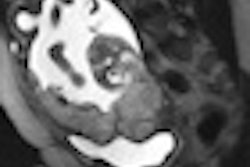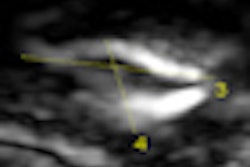There was a 55% increase in the rate of ultrasound utilization among pregnant women between 1996 and 2006 in the Canadian province of Ontario, according to a study published online January 4 in the Canadian Medical Association Journal.
The study tracked the rate of prenatal ultrasound usage in Ontario over 10 years. (Neurology, January 2010, Vol. 74, pp. 194-200).The investigators found the increase was similar for women with high- and low-risk pregnancies and that it was primarily due to a rise in the rate of first-trimester scans (CMAJ, January 4, 2010, published online ahead of print).
1.4 million scans
A research team led by principal investigator Dr. John You of McMaster University in Hamilton analyzed 1,399,389 singleton deliveries between 1996 and 2006 by analyzing records of hospital admissions in the Canadian Institute for Health Information's Discharge Abstract Database.
The group obtained data on the number of obstetric deliveries and types of maternal comorbidities, finding that the rate of ultrasound exams rose linearly from 2,055 per 1,000 pregnancies in 1996 to 3,264 per 1,000 pregnancies in 2006.
The increase was similar for low-risk pregnancies (growth rate of 54%) and high-risk pregnancies (growth rate of 55%). High-risk pregnancies were defined as those associated with a maternal comorbidity, genetics consultation, amniocentesis, or complications in a previous pregnancy. Comorbidities were defined as diabetes, hypertension, thyroid disease, cardiac disease, rheumatologic disease, venous thromboembolism, renal disease, epilepsy, or hospital admission for supervision of a high-risk pregnancy.
The growth rate for ultrasound also showed a statistically significant increase in all three trimesters between 1996 and 2006. However, it was highest in the first trimester, at 98%, followed by the third trimester at 55% and the second trimester at 38%. The highest growth rate occurred in the first trimester among low-risk pregnancies, at 203%.
The proportion of women who had four or more fetal ultrasound exams in the second or third trimester jumped from 6.4% in 1996 to 18.7% in 2006. Most of this increase occurred in low-risk pregnancies. Moreover, fully 37.2% of all women received three or more ultrasounds during their second and third trimesters.
Signs of overuse?
Although the study's findings are provocative, do they necessarily point to overuse of obstetrical radiology in Canada? Much of the increase could be explained by changing demographics, according to Dr. Deborah Levine, chair of the Ultrasound Commission at the American College of Radiology (ACR) in Reston, VA.
"I was surprised to see so many women were getting four or more ultrasounds," commented Levine, who was not involved in the study. "But if you see the percentage of women who were 35 or older -- 20.4% in 2006, compared to 15.1% in 1996 -- that can help explain it."
The changes seen in the Canadian study are similar to those that have occurred in the U.S., and in addition to the demographic factors, they could also be explained by new clinical indications for the modality.
"A large part of the increase is due to increased screening for chromosome abnormalities in the first trimester," Levine told AuntMinnie.com. "There is also more obesity in our population, making clinical examination difficult."
Among the study's limitations were that investigators did not classify obesity as a maternal comorbidity, Levine said. In addition, the authors estimated the trimester in which the ultrasounds were performed -- and therefore ultrasound exams performed in the first trimester could have been ascribed to later in the pregnancy.
"I think conducting a study in the U.S. that has a slightly different design, that can help address some of these limitations, would be good," Levine concluded.
The Canadian study parallels statistics in the U.S. that document a drastic increase in prenatal ultrasound in the U.S. between 1984 and 2000 -- from 15% to 40% of pregnant women receiving at least one ultrasound to nearly 67%, according to another independent observer, Dr. Uma Reddy, a medical officer in the pregnancy and perinatology branch of the Eunice Kennedy Shriver National Institute of Child Health and Human Development at the National Institutes of Health (NIH) in Bethesda, MD.
Reddy agreed with Dr. Levine that updated data would be useful.
"This also needs to be taken in the context of the fact that in contrast to Canada, in the U.S. it is not routine to offer all low-risk women a second-trimester ultrasound, although many women expect to have this study," she noted.
You, the study's principal investigator, agreed that more direct and detailed assessment of indications for ultrasound exams would provide more information about the extent, if any, of overutilization.
He said that in any event, an effort should be undertaken to increase awareness of the current Canadian guidelines, which recommend two ultrasound studies in low-risk pregnancies: a first-trimester nuchal translucency screening and a second-trimester anatomical scan.
"It is also important for patients to talk to their doctors when ultrasound tests are being ordered, so that patients understand what the rationale is for the test, what information is being sought, and how the results will influence management of the pregnancy," You said.
The study was funded by an operating grant from the Canadian Institutes of Health Research and supported by the Institute for Clinical Evaluative Sciences.
By Rosemary Frei
AuntMinnie.com contributing writer
January 7, 2010
Related Reading
Screening for Down syndrome can start with biochemistry, November 12, 2009
Diagnosis, abortion of Down's babies rising in U.K., October 27, 2009
Ultrasound not needed for infants with single umbilical artery, July 16, 2009
Copyright © 2010 AuntMinnie.com



















